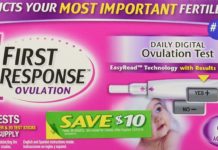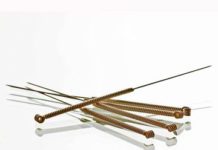
My husband and I had been trying to get pregnant for about nine months when I worked up the nerve to take yet another at-home pregnancy test. But this time it felt different as I carefully unwrapped the pink-and-white package.
After months of trying with no luck, I'd begun to worry—I was 35, the dreaded threshold when getting pregnant can become more difficult and pregnancies can be riskier. So I had started using ovulation predictors and charting my basal body temperature to pinpoint the best times to try. After a few more months of that, I felt like this might finally be the moment—I did everything right, right?
I rose early that morning, my stomach fluttering with anticipation, and made certain to follow the instructions to the letter. As the seconds ticked by, I thought about all I'd done leading up to this moment. Then I picked up the plastic wand and stared at the tiny window that would show two pink lines if I were pregnant. No matter how hard I squinted, all I saw was a single line in the middle of stark whiteness. A few days later, my period came, and the cycle of disappointment began anew.
I continued that rollercoaster ride for several more months, growing more desperate and crestfallen with every failed cycle. And as I continued to chart my temperature fluctuations during my cycle, I noticed something amiss. We often hear about the 28-day cycle, which has three parts: the follicular phase, which is when ovarian follicles mature in preparation to release an egg; ovulation, when a mature egg is released and fertilization can occur; and the luteal phase, the time between ovulation and menstruation when the production of progesterone is amped up, helping thicken the uterine lining for a fertilized egg to implant, causing pregnancy.
A normal luteal phase usually lasts between 12-14 days. Mine was generally between 7-9 days. Even though my cycles hovered around the usual 28 days, I could tell by my temperature fluctuations that I almost always ovulated later than the typical mid-cycle point of day 14 we so often hear about. And thus, there were only a few days after ovulation before my period would begin.
So, I called my OB-GYN to tell her what I'd discovered. She agreed I needed testing to determine if I had a progesterone deficiency, but she and her nurse insisted the test be done on the 21st day of my cycle. In doing extensive research about what might be happening, I knew that day 21 testing was based on a 28-day cycle in which a woman ovulates on or around the 14th day. If a woman has longer cycles or ovulates later, the testing time should be adjusted—it should be done 7 days after ovulation. I knew that if I was tested on the 21st day, the results would likely be misleading because I would either just have or not yet ovulated.
I tried explaining this, but my doctor wouldn't budge. I felt like I was wasting time I didn't have at my age, so I made the difficult decision to find a new doctor who would administer my testing correctly. I switched to a practice that had a reproductive endocrinologist on staff, feeling more confident I'd get my testing done at the correct time in an office that specializes in fertility issues.
The results of my test confirmed what I already suspected—my progesterone levels were very low, and my new doctor diagnosed me with a luteal phase defect. This solved the mystery of why I still hadn't gotten pregnant, and my doctor also explained that if I had somehow gotten pregnant, the defect would have put me at very high risk for a miscarriage.
To remedy this condition, my doctor prescribed a progesterone supplement pill (Prometrium), that I was to take as soon as I detected ovulation. The day after I got the telltale basal body temperature spike that indicates ovulation, I began taking the meds, hoping that this might make a difference.
Two weeks later, I was beginning to feel a bit more optimistic—my period still hadn't arrived, and my luteal phase was finally a normal length. I continued monitoring my temperature, and when I noticed another spike, I decided to try taking another test. This time, I saw two distinct pink lines—after a year of trying, I was finally pregnant!
But that wasn't the end of my hormone treatment. Once I became pregnant, my doctor wanted me to continue on the progesterone supplement—this time in suppository form—throughout the first trimester to ensure I didn't miscarry. While it certainly wasn't the most pleasant experience, it was totally worth it to make it through that first stage of pregnancy with no issues. And I was rewarded with the birth of my child—a healthy baby boy—a few months later.
While my story ended happily, I can't help wondering how many women experience the same hormonal deficiencies and don't have the knowledge to advocate for themselves to get the proper testing and medication. Had I not done significant research, monitored my basal body temperature, and pushed to get the proper testing done at the correct time, I might not have ended up pregnant.
If you think something isn't right, ask questions and don't be afraid to stand up for yourself, even with your doctor—any discomfort you may feel advocating for yourself will be totally worth it when you hold your baby in your arms.
































